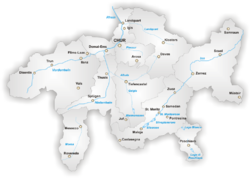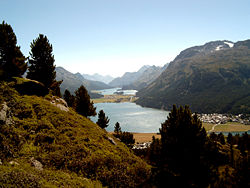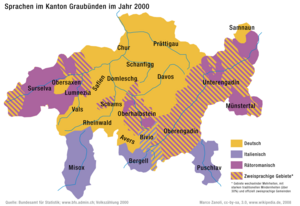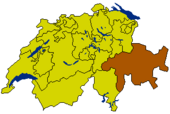Graubünden
| Kanton Graubünden Chantun Grischun Cantone dei Grigioni |
|||
|
|||
| Capital | Chur | ||
| Population (2007) | 188,762 (Ranked 14th) | ||
| - Density | 26 /km² | ||
| Area | 7105 km² (Ranked 1st) | ||
| Highest point | 4049 m - Piz Bernina | ||
| Lowest point | 260 m - border to Ticino at San Vittore | ||
| Joined | 1803 | ||
| Abbreviation | GR | ||
| Languages | German, Romansh, Italian | ||
| Executive | Regierungsrat Regenza, Governo (5) |
||
| Legislative | Grosser Rat, cussegl grond, Grand Consiglio (120) | ||
| Municipalities | 203 municipalities | ||
| Districts | 11 Bezirke | ||
| Website | www.GR.ch | ||
 |
|||
Graubünden or Grisons (German: Graubünden, IPA: [gʁaʊˈbyndən]; Italian: Grigioni [gɾiˈdʒoːni]; Romansh: Grischun [gɾiˈʒun]) is the largest and easternmost canton of Switzerland. The name Graubünden translates as "Grey Leagues," referring to the canton's origin in three local alliances, the League of God's House, the Grey League, and the League of Ten Jurisdictions.
Contents |
Geography
The area of the canton is 7,105.2 square kilometers (2,743.3 sq mi)[1]. Only about a third of this is commonly regarded as productive land[1]. Forests cover about a fifth of the total area[1]. The canton is almost entirely mountainous, comprising the highlands of the Rhine and Inn river valleys. Many of its scenic areas are part of the Swiss National Park or the Ela Nature Park.

There are many significant elevations in the Grison Alps, including the Tödi at 3,614 m and the highest peak Piz Bernina at 4,049 meters (13,284 ft). Many of the mountain ranges feature extensive glaciers, such as at the Adula, the Albula, the Silvretta, the Bernina, the Bregaglia and the Rätikon ranges. The mountain ranges in the central area are very deep, some of which are considered the deepest valleys in Europe. These valleys were originally settled by the Raetians (Rhaeti).
The canton borders on Liechtenstein to the north, Austria to the north and the east, Italy to the south and southeast, and the cantons of St. Gallen to the northwest, Canton of Glarus, Uri to the west, and Ticino to the southwest. The capital city is Chur. The world-famous resorts of Davos, Klosters and St. Moritz are located in the canton.
History
Most of the lands of the canton were once part of a Roman province called Raetia which was established in 15 BC. The area later was part of the lands of the diocese at Chur.
In 1367 the League of God's House (Cadi, Gottes Haus, Ca' di Dio), was founded to resist the rising power of the Bishop of Chur. This was followed by the establishment of the Grey League (Grauer Bund), sometimes called Oberbund, in 1395 in the Upper Rhine valley. The name Grey League is derived from the homespun grey clothes worn by the people. The name of this league later gave its name to the canton of Graubünden. A third league was established in 1436 by the people of ten bailiwicks in the former Toggenburg countship, as the dynasty of Toggenburg had become extinct. The league was called League of the Ten Jurisdictions (Zehngerichtebund).
The first step towards the canton of Graubünden was when the league of the Ten Jurisdictions allied with the League of God's House in 1450. In 1471 the two leagues allied with the Grey League. In 1497 and 1498 the Leagues[2] allied with the Old Swiss Confederacy after the Habsburgs acquired the possessions of the extinct Toggenburg dynasty in 1496[3], siding with the Confederacy in the Swabian War three years later. The Habsburgs were defeated at Calven Gorge and Dornach, helping the Swiss Confederation and the allied leagues of the canton of Grisons to be recognised. However the Three Leagues remained a loose association until the Bundesbrief of September 23, 1524[4].
The last traces of the Bishop of Chur's jurisdiction were abolished in 1526. The Musso war of 1520 drove the Three Leagues closer to the Swiss Confederacy. In 1798, the lands of the canton of Graubünden became part of the Helvetic Republic as the Canton of Raetia. With the Act of Mediation the "perpetual ally" of Switzerland became a canton in 1803. The constitution of the canton dates from 1892. In the following century, there have been about 30 changes made to the constitution[5].
The arms of the three original leagues are now all part of the coat of arms of the canton.
Culture

The Graubünden are known for a dried-beef delicacy called Bündnerfleisch and for a nut and honey pie known as Bündner Nusstorte. Another specialty, predominantly made in the western part of Grison, is Capuns[6] a hearty meal of meat, cheese and salad leaves.
Economy
Agriculture and tourism are the pillars of the canton's economy. Agriculture includes forests and mountain pasturage in summer, particularly of sheep and goats. Tourism is concentrated in the mountains, particularly around the towns of Davos/Arosa, Laax and St. Moritz/Pontresina. There are, however, a great number of other tourist resorts in the canton.
There is wine production around the capital Chur. Chur is also an industrial centre. In the southern valleys of Mesolcina and Poschiavo there is corn (maize) and chestnut farming.
Public Transport
Public transport is provided by an integrated timetable of Postbuses and the Rhaetian Railway, the largest narrow-gauge railway network in Switzerland in which the cantonal government is the largest shareholder. The Swiss Federal Railways only extend a few kilometres into the canton, to the capital, Chur, where passengers transfer to the RhB. "Rhaetia" is a Latin name for the area.
Demographics

The languages spoken in Graubünden are German in the northwest (68%), Romansh in the Engadin and around Disentis/Mustér (15%), and Italian in the valleys Mesolcina, Calanca, Val Bregaglia, and Poschiavo (10%) with the additional 7% speaking another language[7]. Graubünden is the only canton of Switzerland with three official languages.
Romansh is an umbrella term covering a group of closely-related dialects, spoken in southern Switzerland and all belonging to the Rhaeto-Romance language family. These dialects include Sursilvan, Sutsilvan, Surmiran, Puter and Vallader. Romansh was nationally standardised in 1982 by Zürich-based linguist Heinrich Schmid. The standardised language, called Rumantsch Grischun, has been slowly accepted. Romansh has been recognized as one of four "national languages" by the Swiss Federal Constitution since 1938. It was also declared an "official language" of the Confederation in 1996, meaning that Romansh speakers may use Rumantsch Grischun for correspondence with the federal government and expect to receive a response in the same language. Romansh has an official language at a cantonal level. Municipalities in turn are free to specify their own official languages.
The main religions are Catholicism and Protestantism. Both are well-represented in the canton, with Roman Catholics forming a slight majority (47% Catholic to 41% Protestant)[8].
The population of Graubünden is 188,762 (2007) of which 28,008 (or 14.84%) are foreigners[9].
Districts

Canton Graubünden is divided into 11 Districts. They tend to follow the natural boundaries of the landscape. The districts are further subdivided into 39 sub-districts (German: Kreise):
- Albula with the sub-districts Alvaschein, Belfort, Bergün and Surses
- Bernina with the sub-districts Brusio and Poschiavo
- Hinterrhein with the sub-districts Avers, Domleschg, Rheinwald, Schams and Thusis
- Imboden with the sub-districts Trins and Rhäzüns
- Inn with the sub-districts Ramosch, Sur Tasna, Suot Tasna and Val Müstair
- Landquart with the sub-districts Maienfeld and Fünf Dörfer
- Maloja with the sub-districts Bergell and Oberengadin
- Moesa with the sub-districts Calanca, Misox and Roveredo
- Plessur with the sub-districts Chur, Churwalden and Schanfigg
- Prättigau/Davos with the sub-districts Davos, Jenaz, Klosters, Küblis, Luzein, Schiers and Seewis
- Surselva with the sub-districts Disentis, Ilanz, Lumnezia/Lugnez, Ruis and Safien
Municipalities
There are 203 municipalities in the canton (as of October 2008[update])[10].
See also: Municipalities of Switzerland
See also
- Swiss Alps
- Three Leagues
- League of the Ten Jurisdictions
- League of God's House
- Grey League
References
- ↑ 1.0 1.1 1.2 Bundesamt fur Statistik (Federal Department of Statistics) (2008). "Regional Statistics for Graubünden". Retrieved on 2008-11-23.
- ↑ Eidgenossenschaft - Konsolidierung und Erweiterung (1353-1515) in German, French and Italian in the online Historical Dictionary of Switzerland.
- ↑ Graubünden, section 3.1.4 - Landesherrschaft und Widerstand im Norden in German, French and Italian in the online Historical Dictionary of Switzerland.
- ↑ Graubünden, section 3.2.4 - Verfassung und Landesgesetze in German, French and Italian in the online Historical Dictionary of Switzerland.
- ↑ Graubünden, section 4.2.2-Von 1848 bis heute in German, French and Italian in the online Historical Dictionary of Switzerland.
- ↑ Capuns recipe
- ↑ Canton of Graubünden Website accessed October 26, 2008 (German) (Italian)
- ↑ Bundesamt fur Statistik (Federal Department of Statistics) (2008). "Wohnbevölkerung nach Religion, nach Kantonen und Städten" (Microsoft Excel). Retrieved on 2008-10-06.
- ↑ Bundesamt fur Statistik (Federal Department of Statistics) (2008). "Ständige Wohnbevölkerung nach Staatsangehörigkeit, Geschlecht und Kantonen" (Microsoft Excel). Retrieved on November 5, 2008.
- ↑ Bundesamt fur Statistik (Federal Department of Statistics) (2008). "Amtliches Gemeindeverzeichnis" (Microsoft Excel). Retrieved on November 5, 2008.
External links
- Graubünden Tourism
- Official Page of the Gouvernment (German) (Italian) (Romansh)
- Official Statistics
- Graubünden in Romansh, German, French and Italian in the online Historical Dictionary of Switzerland.

